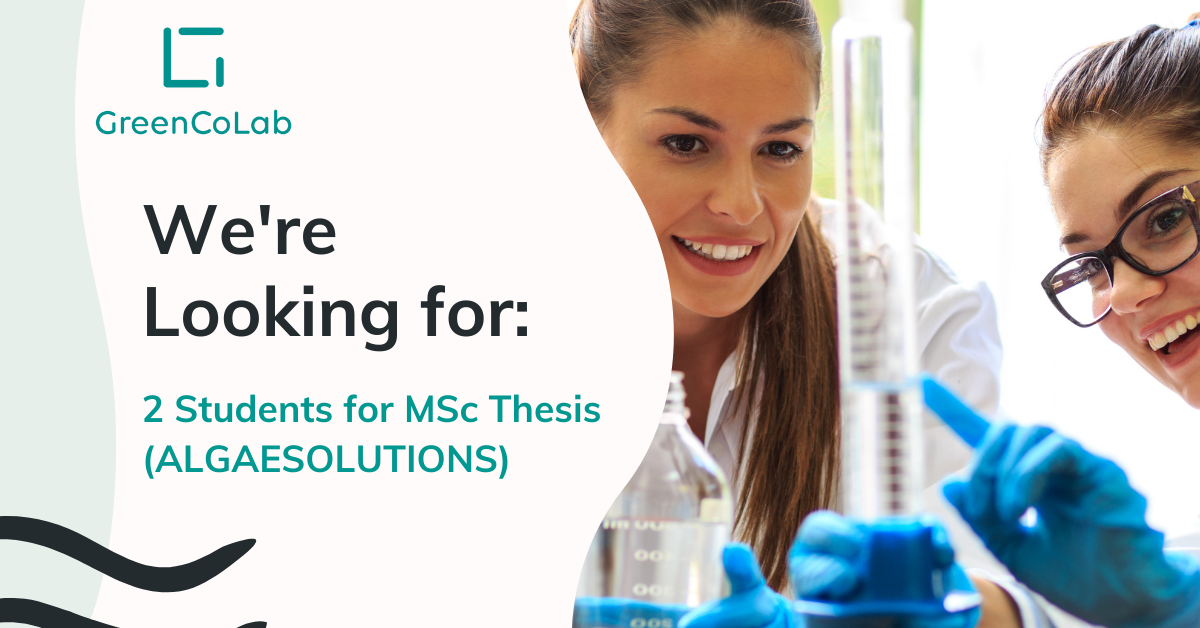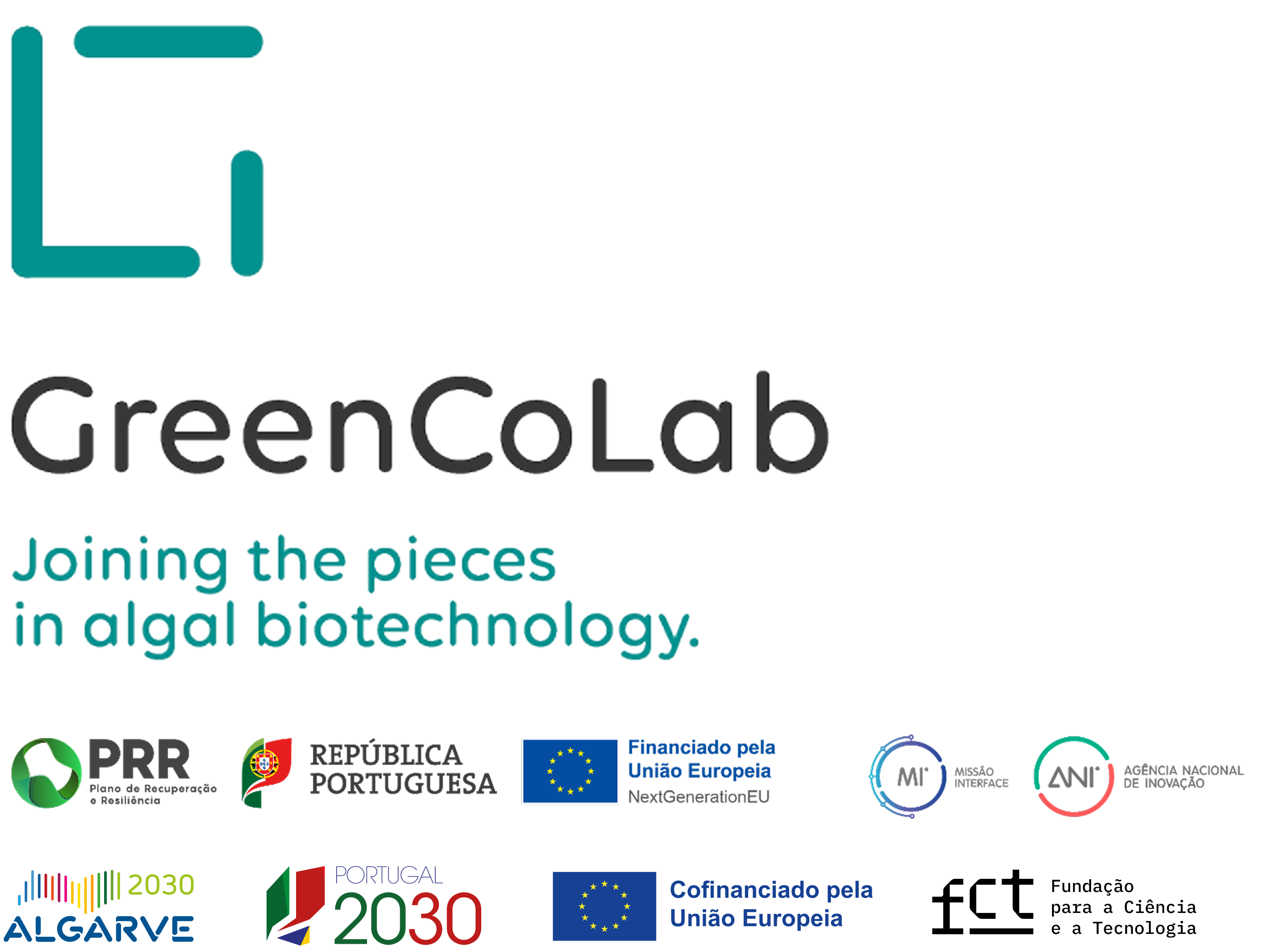
Master thesis proposals in scope of the ALGAESOLUTIONS project
P1: Flashing light for biocompound induction in algae
P2: Optimal light for algae cultivation
Universidade do Algarve
Academic Year: 2021-2022
P1: Flashing light for biocompound induction in algae
Title of Master Thesis
Flashing light for biocompound induction in algae
Scientific Area
Microalgal Biotechnology
Supervisor(s)
João Varela, Universidade do Algarve, Campus de Gambelas, jvarela@ualg.pt
Peter Schulze, Associação Oceano Verde, Universidade do Algarve; peterschulze@greencolab.com
Location
Associação Oceano Verde
Universidade do Algarve, Campus de Gambelas Edf. 12 – Gab. H8
8005-139 Faro, Portugal www.greencolab.com
Goals
- Investigate optimal flashing light conditions and light colours for target biocompound induction (e.g., pigments, fatty acids) in algae.
- Investigate optimal exposure time to flashing light for the induction of target biocompounds in algae.
Abstract
Background: In previous studies, frequencies lower or equal 50 Hz were found to induce pigments or PUFA in various algae. In addition to flashing light, also monochromatic light affects the physiological state of the culture and its biochemical composition. However, both types of light can also inhibit growth and, therefore, the optimal frequency, duty cycle and exposure duration are necessary to obtain the best target metabolite productivity. Previous studies have shown that the application of light to induce target metabolites is particularly promising when applied in a two-stage cultivation approach: First, algae are cultivated under lighting conditions promoting growth until the early exponential phase and only when cultures reach a threshold concentration the metabolite-inducing light treatment should be applied.
Objective: This MSc thesis project will be part of the ALGAESOLUTIONS project and aims to develop strategies of using mono- and multichromatic flashing light for target biocompound induction in algae.
Implementation: Self-made LED modules according to previous studies with monochromatic or multichromatic LEDs will be connected to a pulse width modulator to emit flashing light of different frequencies and duty cycles in a collaborative effort of GreenColab and UALG.
Outlook: The developed knowledge will be used to design LED-based biomass induction systems for specific algae cultures.
Who: You should be interested in microalgal biotechnology, photosynthesis, light, algae cultivation and designing/building of experimental setups. You should also have some lab experience. If you are interest to write your thesis on this topic, contact peterschulze@greencolab.com.
References:
- Lima, S., Schulze, P.S., Schüler, L.M., Rautenberger, R., Morales-Sánchez, D., Santos, T.F., Pereira, H., Varela, J.C., Scargiali, F., Wijffels, R.H. and Kiron, V., 2021. Flashing light emitting diodes (LEDs) induce proteins, polyunsaturated fatty acids and pigments in three microalgae. Journal of Biotechnology, 325, pp.15-24.
- Schulze, P.S., Barreira, L.A., Pereira, H.G., Perales, J.A. and Varela, J.C., 2014. Light emitting diodes (LEDs) applied to microalgal production. Trends in biotechnology, 32, pp.422-430.
- Schulze, P.S., Brindley, C., Fernández, J.M., Rautenberger, R., Pereira, H., Wijffels, R.H. and Kiron, V., 2020. Flashing light does not improve photosynthetic performance and growth of green microalgae. Bioresource Technology Reports, 9, p.100367.
Schedule
Experimental start: November 2021
Experimental end: June 2022
P2: Optimal light for algae cultivation
Title of Master Thesis
Optimal light for algae cultivation
Scientific Area
Microalgal Biotechnology
Supervisor(s)
João Varela, Universidade do Algarve, Campus de Gambelas, jvarela@ualg.pt
Peter Schulze, Associação Oceano Verde, Universidade do Algarve; peterschulze@greencolab.com
Location
Associação Oceano Verde
Universidade do Algarve, Campus de Gambelas Edf. 12 – Gab. H8
8005-139 Faro, Portugal www.greencolab.com
Goals
- Investigate optimal combinations of blue, red and green lights for photosynthetic performance at specific light intensities and culture concentrations in photobioreactors.
- Develop models to predict optimal light regimes for algal cultures.
Abstract
Background: The major bottlenect in photoautotrophic microalgal cultivation is the delivery of light with the right properties to drive photosynthesis in all microalgal cells within a culture. One of the major problems of algal cultivation are the cells at the periphery, which prevent penetration of light into the phtobioreactor (PBR), limiting the photosynthetic efficiency and productivity of the whole culture. To improve the delivery of photons to cells in a culture, optimal wavelengths and light intensities need to be identified for a target species and culture concentration.
Objective: This MSc thesis project will be part of the ALGAESOLUTIONS project and aims to develop models based on laboratory experiments that predict the required light intensity of algal cultures at a given growth stage that can be applied to the facilities of industrial partners.
Implementation: The photosynthetic oxygen evolution will be measured in different microalgal cultures inside a photosynthetic chamber. Different LED combinations will be tested at different light intensities and biomass concentrations. The photosynthetic oxygen evolution rates obtained will be modelled and analysed. Secondly, to validate the model, cultures will be grown indoors in batch cultures under light regimes that were predicted from the model established. Samples will be collected to calculate the growth rates, biomass productivities, maximum biomass concentration, yield and to determine photosynthetic efficiency of algal cultures and biochemical composition of the biomass.
Outlook: The developed knowledge will be used to design smart LED lighting systems that are tailored to the need of a specific culture.
Who: You should be interested in microalgal biotechnology, photosynthesis, algae cultivation and designing/building of experimental setups. You should also have some lab experience. If you are interest to write your thesis on this topic, contact peterschulze@greencolab.com.
References:
- Blanken, W., Cuaresma, M., Wijffels, R.H. and Janssen, M., 2013. Cultivation of microalgae on artificial light comes at a cost. Algal Research, 2, pp.333-340.
- Ooms, M.D., Dinh, C.T., Sargent, E.H. and Sinton, D., 2016. Photon management for augmented photosynthesis. Nature Communications, 7, pp.1-13.
- Schulze, P.S., Barreira, L.A., Pereira, H.G., Perales, J.A. and Varela, J.C., 2014. Light emitting diodes (LEDs) applied to microalgal production. Trends in biotechnology, 32, pp.422-430.
- Schulze, P.S., Brindley, C., Fernández, J.M., Rautenberger, R., Pereira, H., Wijffels, R.H. and Kiron, V., 2020. Flashing light does not improve photosynthetic performance and growth of green microalgae. Bioresource Technology Reports, 9, p.100367.
Schedule
Experimental start: November 2021
Experimental end: June 2022



